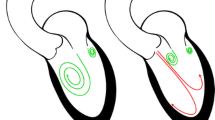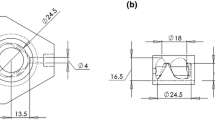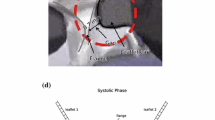Abstract
Aortic valve (AV) calcification is a highly prevalent disease with serious impact on mortality and morbidity. The exact causes and mechanisms of AV calcification are unclear, although previous studies suggest that mechanical forces play a role. It has been clinically demonstrated that calcification preferentially occurs on the aortic surface of the AV. This is hypothesized to be due to differences in the mechanical environments on the two sides of the valve. It is thus necessary to characterize fluid shear forces acting on both sides of the leaflet to test this hypothesis. The current study is one of two studies characterizing dynamic shear stress on both sides of the AV leaflets. In the current study, shear stresses on the ventricular surface of the AV leaflets were measured experimentally on two prosthetic AV models with transparent leaflets in an in vitro pulsatile flow loop using two-component Laser Doppler Velocimetry (LDV). Experimental measurements were utilized to validate a theoretical model of AV ventricular surface shear stress based on the Womersley profile in a straight tube, with corrections for the opening angle of the valve leaflets. This theoretical model was applied to in vivo data based on MRI-derived volumetric flow rates and valve dimension obtained from the literature. Experimental results showed that ventricular surface shear stress was dominated by the streamwise component. The systolic shear stress waveform resembled a half-sinusoid during systole and peaks at 64–71 dyn/cm2, and reversed in direction at the end of systole for 15–25 ms, and reached a significant negative magnitude of 40–51 dyn/cm2. Shear stresses from the theoretical model applied to in vivo data showed that shear stresses peaked at 77–92 dyn/cm2 and reversed in direction for substantial period of time (108–110 ms) during late systole with peak negative shear stress of 35–38 dyn/cm2.
Similar content being viewed by others
References
Balachandran K, Sucosky P, Jo H, Yoganathan AP (2009) Elevated cyclic stretch alters matrix remodeling in aortic valve cusps: implications for degenerative aortic valve disease. Am J Physiol Heart Circ Physiol 296(3): H756–H764
Bellhouse BJ, Reid KG (1969) Fluid mechanics of the aortic valve. Br Heart J 31(3): 391
Butcher JT, Tressel S, Johnson T, Turner D, Sorescu G, Jo H, Nerem RM (2006) Transcriptional profiles of valvular and vascular endothelial cells reveal phenotypic differences: influence of shear stress. Arterioscler Thromb Vasc Biol 26(1): 69–77
Carmody CJ, Burriesci G, Howard IC, Patterson EA (2006) An approach to the simulation of fluid-structure interaction in the aortic valve. J Biomech 39(1): 158–169
Cerny L, Walawender W (1966) The flow of a viscous liquid in a converging tube. Bull Math Biol 28(1): 11–24
De Hart J, Peters GW, Schreurs PJ, Baaijens FP (2003) A three-dimensional computational analysis of fluid-structure interaction in the aortic valve. J Biomech 36(1): 103–112
De Hart J, Peters GW, Schreurs PJ, Baaijens FP (2004) Collagen fibers reduce stresses and stabilize motion of aortic valve leaflets during systole. J Biomech 37(3): 303–311
Freeman RV, Otto CM (2005) Spectrum of calcific aortic valve disease: pathogenesis, disease progression, and treatment strategies. Circulation 111(24): 3316–3326
Ge L, Sotiropoulos F (2010) Direction and magnitude of blood flow shear stresses on the leaflets of aortic valves:is there a link with valve calcification?. J Biomech Eng 132(1): 014505
Hale JF, Mc DD, Womersley JR (1955) Velocity profiles of oscillating arterial flow, with some calculations of viscous drag and the Reynolds numbers. J Physiol 128(3): 629–640
Langerak SE, Kunz P, Vliegen HW, Lamb HJ, Jukema JW, van Der Wall EE, de Roos A (2001) Improved MR flow mapping in coronary artery bypass grafts during adenosine-induced stress. Radiology 218(2): 540–547
Leo HL, Dasi LP, Carberry J, Simon HA, Yoganathan AP (2006) Fluid dynamic assessment of three polymeric heart valves using particle image velocimetry. Ann Biomed Eng 34(6): 936–952
Leyh RG, Schmidtke C, Sievers HH, Yacoub MH (1999) Opening and closing characteristics of the aortic valve after different types of valve-preserving surgery. Circulation 100(21): 2153–2160
Lindroos M, Kupari M, Heikkila J, Tilvis R (1993) Prevalence of aortic valve abnormalities in the elderly:an echocardiographic study of a random population sample. J Am Coll Cardiol 21(5): 1220–1225
Makhijani VB, Yang HQ, Dionne PJ, Thubrikar MJ (1997) Three-dimensional coupled fluid-structure simulation of pericardial bioprosthetic aortic valve function. ASAIO J 43(5): M387–M392
Morsi YS, Yang WW, Wong CS, Das S (2007) Transient fluid-structure coupling for simulation of a trileaflet heart valve using weak coupling. J Artif Organs 10(2): 96–103
Powell AJ, Maier SE, Chung T, Geva T (2000) Phase-velocity cine magnetic resonance imaging measurement of pulsatile blood flow in children and young adults: in vitro and in vivo validation. Pediatr Cardiol 21(2): 104–110
Rao AR, Devanathan R (1973) Pulsatile flow in tubes of varying cross-sections. Zeitschrift für Angewandte Mathematik und Physik (ZAMP) 24(2): 203–213
Ren-jing C, Chan Q (1993) Boundary layer development of pulsatile blood flow in a tapered vessel. Appl Math Mech 14(4): 319–326
Roman MJ, Devereux RB, Kramer-Fox R, O’Loughlin J (1989) Two-dimensional echocardiographic aortic root dimensions in normal children and adults. Am J Cardiol 64(8): 507–512
Sacks MS, Schoen FJ, Mayer JE (2009) Bioengineering challenges for heart valve tissue engineering. Ann Rev Biomed Eng 11: 289–313
Sarraf CE, Harris AB, McCulloch AD, Eastwood M (2002) Tissue engineering of biological cardiovascular system surrogates. Heart Lung Circ 11(3): 142–150 (Discussion 151)
Smith KE, Metzler SA, Warnock JN (2010) Cyclic strain inhibits acute pro-inflammatory gene expression in aortic valve interstitial cells. Biomech Model Mechanobiol 9(1): 117–125
Stevens T, Rosenberg R, Aird W, Quertermous T, Johnson FL, Garcia JG, Hebbel RP, Tuder RM, Garfinkel S (2001) NHLBI workshop report: endothelial cell phenotypes in heart, lung, and blood diseases. Am J Physiol Cell Physiol 281(5): C1422–C1433
Sucosky P, Balachandran K, Elhammali A, Jo H, Yoganathan AP (2009) Altered shear stress stimulates upregulation of endothelial VCAM-1 and ICAM-1 in a BMP-4- and TGF-beta1-dependent pathway. Arterioscler Thromb Vasc Biol 29(2): 254–260
Thubrikar M (1990) The aortic valve. CRC Press, Boca Raton
Thubrikar M, Piepgrass WC, Shaner TW, Nolan SP (1981) The design of the normal aortic valve. Am J Physiol 241(6): H795–H801
Topper JN, Gimbrone MAJr (1999) Blood flow and vascular gene expression: fluid shear stress as a modulator of endothelial phenotype. Mol Med Today 5(1):40–46
Weinberg EJ, Kaazempur Mofrad MR (2008) A multiscale computational comparison of the bicuspid and tricuspid aortic valves in relation to calcific aortic stenosis. J Biomech 41(16): 3482–3487
Weston MW, LaBorde DV, Yoganathan AP (1999) Estimation of the shear stress on the surface of an aortic valve leaflet. Ann Biomed Eng 27(4): 572–579
Xing Y, Warnock JN, He Z, Hilbert SL, Yoganathan AP (2004) Cyclic pressure affects the biological properties of porcine aortic valve leaflets in a magnitude and frequency dependent manner. Ann Biomed Eng 32(11): 1461–1470
Yap CH, Dasi LP, Yoganathan AP (2010) Dynamic hemodynamic energy loss in normal and stenosed aortic valves. J Biomech Eng 132(2): 021005
Yap CH, Kim HS, Balachandran K, Weiler M, Haj-Ali R, Yoganathan AP (2010) Dynamic deformation characteristics of porcine aortic valve leaflet under normal and hypertensive conditions. Am J Physiol Heart Circ Physiol 298(2): H395–H405
Yap CH, Saikrishnan N, Tamilselvan G, Yoganathan AP (2011) Experimental measurement of dynamic fluid shear stress on the aortic surface of the aortic valve leaflet. Biomech Model Mechanobiol [Accepted 4 March 2011]
Zeng Z, Yin Y, Jan KM, Rumschitzki DS (2007) Macromolecular transport in heart valves. II. Theoretical models. Am J Physiol Heart Circ Physiol 292(6): H2671–H2686
Author information
Authors and Affiliations
Corresponding author
Rights and permissions
About this article
Cite this article
Yap, C.H., Saikrishnan, N. & Yoganathan, A.P. Experimental measurement of dynamic fluid shear stress on the ventricular surface of the aortic valve leaflet. Biomech Model Mechanobiol 11, 231–244 (2012). https://doi.org/10.1007/s10237-011-0306-2
Received:
Accepted:
Published:
Issue Date:
DOI: https://doi.org/10.1007/s10237-011-0306-2




